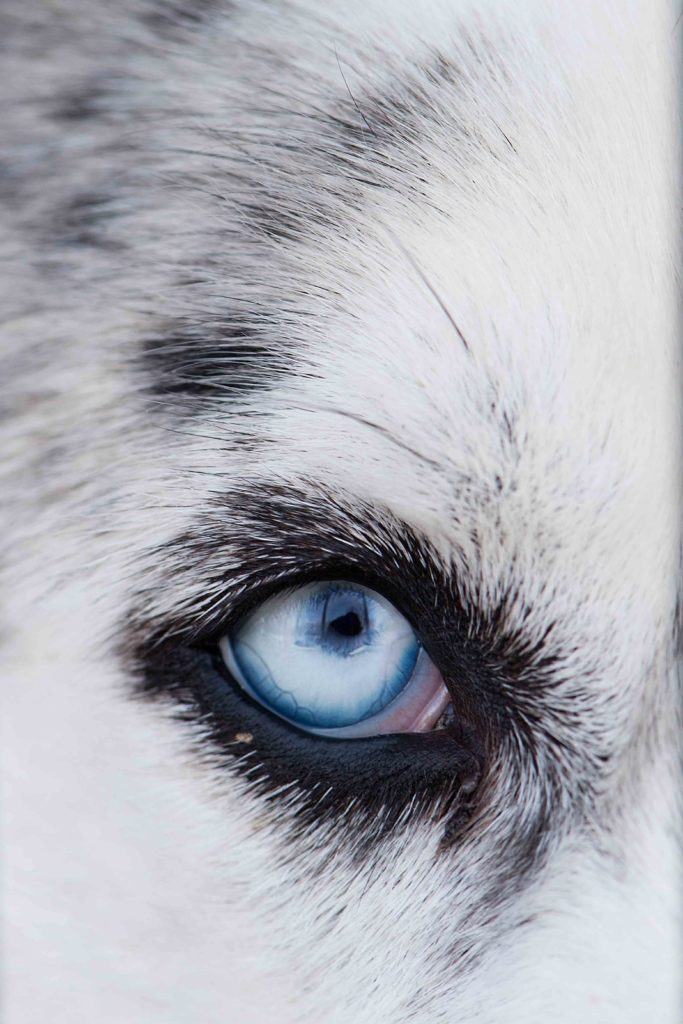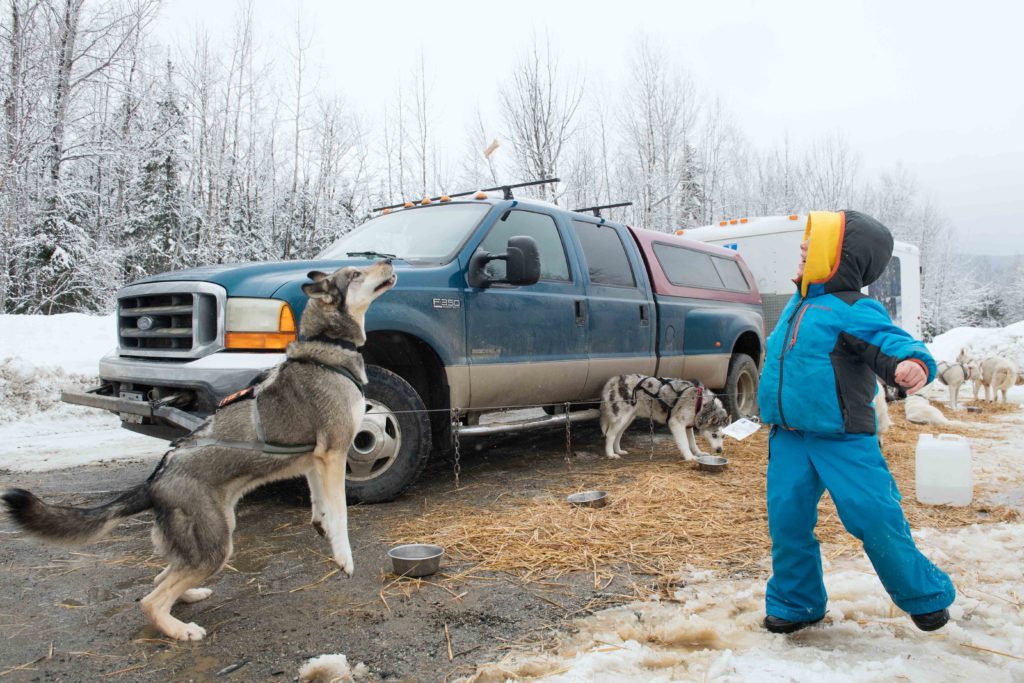Mushing Through the Snow
Maine native Kate Ray and her family bring dogsledding back to Sugarloaf.

Mushing
Through the
Snow
Maine native Kate Ray and her family bring dogsledding back to Sugarloaf.
Issue: December 2019
By: Susan Axelrod
Photography by: Nicole Wolf
Adding several inches to Sugarloaf’s already substantial snowpack, an overnight storm made a marshmallow world of Carrabassett Valley on this Saturday in late March. As I pull into a parking area just beyond the mountain access road to meet Kate and Brian Ray of Dogsled Maine, the top of Sugarloaf is still veiled in clouds rolling across what will later become a bluebird sky. High snowbanks surround the small lot, which is dominated by the Rays’ dog-transport rig: a Ford F350 truck with a white box trailer emblazoned with a logo for Eagle Mountain Sled Dogs. Between extensions to the front bumper of the truck and the rear bumper of the trailer, a tether cable holds eight huskies insulated from the icy ground by a bed of straw. The dogs—some with classic gray, black, and white husky coats, others with pure white fur—all wear harnesses with their names: Yukon, Kato, Sol, Quivet, H2, Summit, Denver, and Calypso.

Trying to stay on top of the snow, I trudge through the drifts to join the Rays and photographer Nicole Wolf. (When I take a step and sink up to my thigh, Kate tells me with a grin that this is called “post-holing.”) Because it is so deep, Brian spent part of the morning carving trails with a snowmobile through the trees and across the buried fairways of the Sugarloaf Golf Club. He watches the couple’s young children, Finn, age four, and Tallula (Lula), age two, play while Kate leads dogs from the tether and clips them to the gangline that tows the sled. Summit, an eight-year-old Seppala (a mixed-breed husky), is the leader, followed by three rows of dogs that will run in pairs. They howl and leap with excitement, except for Sol, a seven-year-old Siberian, who rolls onto his back to exuberantly wriggle in the snow. “We call that an Alaskan flat tire,” Kate jokes.
Kate, who grew up in Buxton, adopted her first husky from Western Maine Siberian Husky Rescue during her freshman year in college. “I always had stuffed husky toys as a kid,” she says. “As soon as I found out about them, I knew they were the dog for me.” By the time she graduated from the University of Maine in Farmington, she had adopted five more huskies, and from 2004 to 2006 she ran dogsled rides at Sugarloaf, where she had also worked on the ski patrol. Seeking adrenaline-fueled adventure, she then went west, spending her summers in California whitewater kayaking and her winters as a ski patroller in Park City, Utah, in addition to running her photography business. She knew Brian from the mountain at Canyons Resort, where he managed a restaurant, but they didn’t start dating until one summer when she stayed in Utah to photograph whitewater rafting there, and Brian signed her up to play softball. “I had half my head shaved; I had just gotten back from a surfing trip in Columbia, and he thought, ‘This chick’s too intense for me,’” says Kate. They were married in August 2015 in Wyoming’s Grand Teton National Park with one-year-old Finn in attendance. When Lula was born two years later, Kate contacted All Seasons Adventures in Park City, looking for alternatives to working on ski patrol. “They said, ‘If only you knew how to drive a dogsled,’ and I said, ‘Actually I do,’” she recalls. After that first winter, she acquired the dogs and the equipment from the owner of the contracted dog kennel, Eagle Mountain Sled Dogs, who wanted to retire.

The dogs—all rescued huskies—wait for their next run. 
Following a fresh snowfall in late March, the trails of Sugarloaf are just visible through the clouds. 
Like smiling Sol, center left, each dog on the team has their own spot in the trailer that transports them between their kennel at the couple’s home and the mountain.
They had planned to build on land they owned in Park City, but a surge in development prompted them to look elsewhere for the rural life they craved. Brian suggested Maine, and Kate reached out to Sugarloaf about bringing dogsledding back to the mountain, a question to which the answer was an enthusiastic yes. In October 2018 the Rays and their kids drove from Utah to Maine pulling their most recent home, an Airstream trailer. They closed on their new house, a farm with 82 acres of land in New Portland, and Kate’s mom stayed with the children while she and Brian flew back to Utah and drove across the country again, towing the white trailer with 15 sled dogs.
Using dogs to transport goods on sleds originated in about 1000 C.E. with the Inuit of northern Canada. During the Klondike Gold Rush at the end of the nineteenth century, sled dogs were bred in large numbers, since dog teams were the most efficient way to get supplies to remote camps for much of the year. However, modern modes of transportation—first the airplane then the snowmobile—transformed dogsled-ding into a recreational activity. The famous Iditarod, which covers nearly 1,000 miles over six days is a relatively new sporting event, having originated in 1973. However, it was inspired by a real event in the winter of 1925 called the Great Race of Mercy, or the Serum Run, when relay teams of sled dogs and mushers raced against time across Alaska on the Iditarod Trail to save the town of Nome from a diphtheria epidemic.

An important part of the Dogsled Maine experience is handing out treats and giving the dogs lots of love after a run. 
Brian hugs H2 while Kate helps the couple’s children, Finn and Lula, into the sled.
For dogsledding enthusiasts like the Rays, the sport is all about the animals. Huskies are working dogs, and while they are affectionate and easy to love, they thrive when given a job. When they don’t have one, they are often problematic as pets. The Rays’ huskies are all rescue dogs, many of which were rejected by previous owners who didn’t understand how to manage the breed. “I love giving them a second chance,” says Kate. “Huskies are such unique dogs because they are so intelligent. They are a challenge. A Labrador can be trained to fetch. The huskies, they look at me like, ‘Well, I could fetch, or I could chase that squirrel, or I could just not listen to you and sit down.’ They have these options in their head that are built in so that you have to try to predict what’s going to happen, and then be able to roll with the punches.”
What huskies will do, predictably and eagerly, is pull. The current team connected to the sled is more than ready to fly as I climb into the sled bag, pull wool blankets up to my armpits, and then tuck the waterproof flap over top. Brian, who holds Summit’s harness at the head of the pack, releases him as Kate calls, “Hike”—musher-speak for “Let’s go”—and we’re off. Loping easily along, the dogs are quiet now, their thick, snowshoe-like paw pads allowing them to tread confidently over the deep snow. The canine excitement of a few moments ago has been replaced by a steady rhythm as we glide through the trees, Kate calling “Gee” to turn the team to the right and “Haw” to turn the dogs to the left. I relax into my snug cocoon and inhale the clear, cold air, feeling both exhilarated and deeply content. There is no sound but the dogs’ breathing, Kate’s firm yet calm commands, and the occasional plop of snow falling from a tree branch.

Dogsled Maine operates on the snow-covered Sugarloaf Golf Course. This season the Rays plan to expand their trail network from three loops to four or five, giving both dogs and riders mor e ground to cover. 
Lead dog Summit is an eight-year-old Seppala husky.
Dogsled Maine offers 40-minute rides for up to two people, or two half-hour rides for four. The sled can carry up to 300 pounds, so the latter option is ideal for families, says Kate. Afterward, hot cocoa with plenty of marshmallows warms up passengers, who are encouraged to give the dogs treats and shower them with affection. “You don’t talk a lot when they’re running because it distracts them, but as soon as they’re done or on a break it’s lots of pats and lots of treats.” I’m more than happy to work my way down the line of dogs on the tether, handing out Milk-Bones and giving hugs to these beautiful animals. Their positions on the tether aren’t random; the Rays know who works out best next to whom. “You have to negotiate personalities,” says Kate. At the end of the day, she leads the dogs to the open back of the trailer, where they easily settle into their spots in a three-tier wall of wooden boxes labeled with their names. Sol rests his big fluffy white head on his paws, which hang over the opening of his box, while Quivet and Summit curl up contentedly, knowing they’ll soon be heading for home.
I follow Kate as she drives the rig to Running Wild Farm in New Portland, where in addition to the sled dogs the Rays now have chickens, sheep, goats, and pigs, as well as two Great Pyrenees house dogs, Boone and Lexi. The huskies are kept separate from the rest of the animals in a spacious kennel with both indoor and outdoor play areas. A six-foot-high fence electrified on the bottom reinforces the separation. “We’re making sure that we’re really smart about it because the huskies are escape artists,” she says. “Huskies don’t have that come-back piece. They’re always moving forward, which is why they’re sled dogs.”

Always moving forward is also an apt description for the Rays, who recently acquired two more huskies, three-year-old Millie and her yet-unnamed puppy, from the Conway Area Humane Society in New Hampshire. Millie has dogsledding experience, and her daughter will ride in the trailer with the other dogs this season, “to get all the love,” says Kate, who plans to expand the trail system from three loops to four or five, to give riders more ground to cover and to “give the dogs more mileage options for when they get into shape.” Brian, who manages Narrow Gauge Food Court in the Sugarloaf Base Lodge, will join his wife as needed, along with Finn and Lula, who add to the experience by romping joyfully in the snow, snuggling the dogs, and making sure everyone gets extra marshmallows on their hot cocoa. On four legs and two, they are a Sugarloaf family in perpetual and happy motion.

